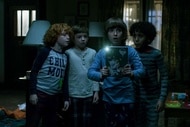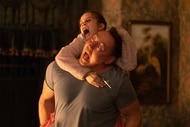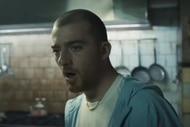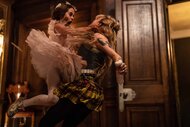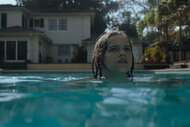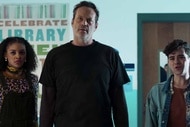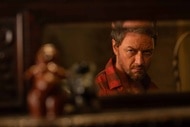Create a free profile to get unlimited access to exclusive videos, sweepstakes, and more!
How two anthology shows made a new generation of horror fans
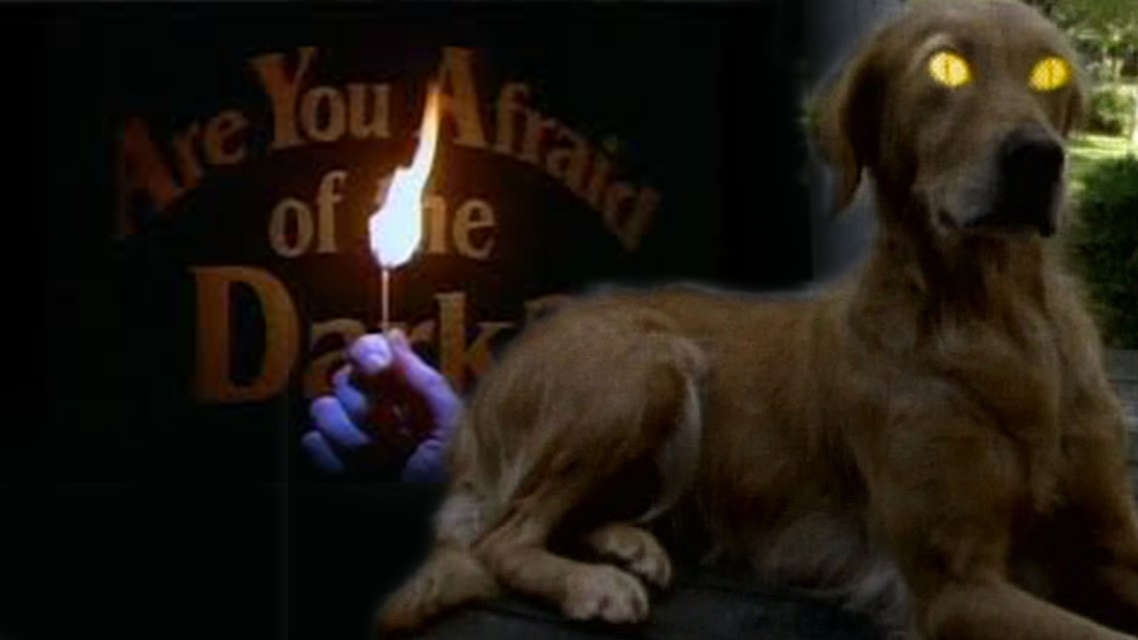
There were plenty of horror anthologies in the '80s, but shows like Tales From the Crypt were essentially R-rated and obviously aimed at grown-ups. It wasn't until the ‘90s that TV started catering to kids who liked to be spooked, as Are You Afraid of the Dark? and Goosebumps helped create a new generation of horror fans. Just in time for Halloween, and to celebrate the shows' 30th and 25th anniversaries — respectively — we're gathering around the campfire, and submitting for the approval of the Midnight Society, a tale of two horror shows and the golden age of kids' horror. Beware — you're in for a scare.
Are You Afraid of the Dark? was the brainchild of D.J. MacHale and Ned Kandel, who actually got their pitch rejected by Nickelodeon when they first tried to sell the show. "We had a little three-page proposal, and they turned us down and said it was too scary for kids," MacHale tells SYFY Wire. It took another pitch meeting after a year before the network was convinced the show could work with a young audience, and Are You Afraid of the Dark? premiered in Canada in 1990 — before its U.S. debut on Nickelodeon a year later.
Anthology shows are tough because audiences get invested in the characters instead of following new ones every week. "That's why we created the Midnight Society," MacHale explains, referring to the teenagers who open and close every episode, a gang of friends who gather at night to tell horror stories in the woods. "Even if they weren't a huge part of the show, people watching the show got to know them and about them so much that you can always kind of tell the kind of story each kid is going to tell."
Though Are You Afraid of the Dark? came at a time where we had many horror anthologies on TV that they could use for influence, the biggest influence on the show was actually The Twilight Zone, and how it balanced drama with horror. "Our number one goal wasn't necessarily to scare kids; we didn't make a fright fest," MacHale said. "When you look at The Twilight Zone, it wasn't really a scary show. It was more odd, weird, and ironic. For Are You Afraid of the Dark? we came up with different types of stories, some dramatic, some flat-out scary, always with some kind of a twist. We set out to make you think, not just flat-out scare; otherwise it would have been way scarier."
Still, there was at least some concern that the show would be too scary for kids, and just to be sure, Nickelodeon had a backup plan. "They asked if we could base some of the stories on literary antecedents," MacHale recalls. "The thinking was that if parents complain about us doing something horrible, Nickelodeon could just say, 'What are you talking about? This is classic literature!'"
Even if parents didn't complain, the show still had plenty of scares to offer, and it often dove into some heavy content, including death. This stems, at least in part, to MacHale's own love for ghost stories. "If you're going to have a ghost story, somebody has to die, because otherwise there is no ghost. The show had a lot of this stuff happen off-camera, like a kid trapped in a closet and starve to death, but since it's off-camera and it happened long ago, it's fine."
Likewise, though it wasn’t scary enough to cause parents to complain, Are You Afraid of the Dark? didn’t always end happily for the kid subject of the story. Some kids die, and even if the kid triumphs in the episode, there was often one last twist. "It's like the old classic cliché horror thing of 'The End …?'" MacHale adds. "There was that moment of doubt. We did it! But then, maybe we didn't."
MacHale credits at least some part of the show's success to the freedom Nickelodeon gave its creators back in the '90s, the time when Nickelodeon went from operating at big losses to becoming one of the biggest players in children's programming, with both Nicktoons like Ren & Stimpy and Rugrats and live-action shows like Clarissa Explains It All and Are You Afraid of the Dark? "There was no interference, nothing on a creative level," MacHale explains. "You have the idea, you go for it. And that's what it was like with all the shows made back then, it was that attitude that really created Nickelodeon and made the show as good as it was."
Right as Are You Afraid of the Dark? was coming to a close, a new horror anthology premiered on Fox Kids and started the big kids' horror wars of the mid-'90s: Goosebumps. Based on the bestselling series of books of the same name by R.L. Stine, Goosebumps was similar enough to spark playground discussions, but different enough that you could be a fan of both and not have much overlap. And not unlike Are You Afraid of the Dark?, it came together thanks to a network executive who knew when to allow for creative freedom.
"Margaret Loesch, who ran Fox Kids at the time, was a true visionary, and she was absolutely in favor of the show and trusted our instincts," Goosebumps co-showrunner Billy Brown tells SYFY WIRE. "I think Scholastic as a company was much more nervous about the show, which was interesting because they had already sold hundreds of thousands of copies of the original books, and what made the books so big is that kids loved being creeped out. We didn't expect the publishers themselves to be so nervous about the show being too scary, but Margaret really went to bat for us."
One key difference between the two horror anthologies is that Goosebumps is much more tongue-in-cheek, taking a cue from the original books. Sure, they were here to scare you, but they were also big into slapstick comedy. "We had specific rules, like no sex, no language, and no violence, but we were going to scare you," co-showrunner Dan Angel explains. "And we were allowed to push the envelope when it came to scary things, but we always treated it like a scary ride at a theme park. While you have your kids in line, they scream and yell not to get on the ride, but as soon as they leave they want to go again."
It also helps that both the Goosebumps books creator and one of the showrunners started out in comedy. Billy Brown started as a writer on Saturday Night Live in the '80s, while R.L. Stine wrote jokes for a comedy magazine before diving into horror. "I never planned to be scary," Stine confesses to SYFY WIRE on a Zoom call. "Seriously, I always just wanted to be funny. It's embarrassing, because being scary wasn't even my idea. A friend at Scholastic suggested that I wrote a horror novel for teenagers, and she even gave me the title. When that became a bestseller, and the next horror novel became a bestseller, I said 'Forget the funny stuff, I'm going to be scary.'"
The stories in Goosebumps, both on the page and on the screen, reflect this comedy background. "I use humor so that it doesn't get too scary," Stine continues. "If I think a scene is getting too intense, I just throw in something funny to lighten it up. Every chapter in the books ends with some big shock that forces you onto the next chapter, and I started to see those as punchlines, because horror and humor are very closely knit. I think you get the same kind of visceral reaction from a joke than from a scare, and that helped make Goosebumps feel different."
Another big difference was that Goosebumps usually involved high-concept stories, like non-linear storytelling, aliens, or a theme park serving as the backlot for a game show hosted by monsters. "Yet no matter how grand the stories were, they were still sort of universal," Brown says. "The kids are suddenly in jeopardy, and they're on their own because the parents were never really important for the show. They were kind of an afterthought. It was all about the kids, and getting these scares to feel like they were happening in your neighborhood and not in a different world."
Goosebumps and Are You Afraid of the Dark? became huge hits for their respective networks, yet Dan Angel confesses that executives remained skeptical about another anthology show. "This applies to family horror and to horror in general, but there was a real aversion in our business to the anthology format that I never understood," Angel says. "And I never understood that because Goosebumps was such a success. And what we tried to make the executives understand is that almost every anthology worked. Whether it was Twilight Zone, Creepshow, or Tales From the Dark Side, every example we showed was a hit, but they still didn't buy it."
Although horror anthologies could be something of a hard sell, Goosebumps and Are You Afraid of the Dark? sparked a small wave of similar shows in the ’90s, like Tales From the Cryptkeeper; Freaky Stories; Eerie, Indiana; and So Weird. But, by the turn of the century, kids' horror started to fade away as Pixar-style animation dominated the family-friendly landscape. "I think these things go in cycles," MacHale says. "If you happen to have a show that hits the psyche at the right place at the right time, it's going to spawn emulators. When Are You Afraid of the Dark? came out, there were a lot of anthology shows for adults, but it just wasn't done for kids, so it sparked the untapped imagination of a new audience."
Horror movies always dig into our deepest fears and manifest them on screen. But no matter how fancy those movies look, or how much money they make, '90s kids know that there was nothing more terrifying than the memory of staying up late and watching short, spooky stories in an anthology show starring kids.
